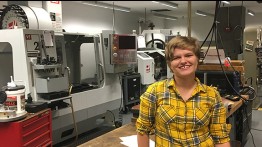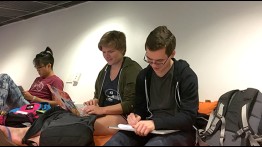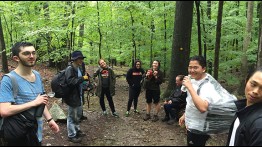Week One: Jenna Scott CE'21
POSTED ON: September 27, 2017
In an effort to better learn about the experiences of first-year students at The Cooper Union's three schools, a member of the communications office followed one student from each school for their first full week of classes. See our introduction. In this installment, Charlotte Egerton, our communications manager, followed Jenna Scott, of the Albert Nerken School of Engineering.
Though she loves architecture, Jenna Scott decided to attend school for civil engineering. Her self-proclaimed "terrible" drawing skills and her talent for math motivated this decision. Jenna visited Cooper Union twice before committing: once on a general tour and once for admitted students day. She vividly remembers meeting Abby Davis, assistant director of admissions, briefly during her first visit. Though she was one of hundreds of prospective engineering students, later that day, Abby remembered her name. That stuck with Jenna. Compared with the other, larger schools where she was applying, the small community at Cooper Union became the deciding factor for her. But she does love the big city atmosphere - “It's the best of both worlds!”
Jenna hails from Grasonville, a town in eastern Maryland. She comes from a big family; at any time her house could include her three younger sisters, half-brother, and two stepsisters. “Dorm living wasn’t an adjustment for me!” Though she does miss having an oven. Students must cook for themselves in a kitchen (sans oven) shared by up to four people in an apartment of the dorm building. “Baking is a stress reliever,” she says. Any East Villagers wanting baked goods and willing to share their oven should take note.
Week One I Day One I Tuesday, September 7
Class One | 9 – 10:50 a.m. | Freshman Seminar
Jenna’s first class of the week was Freshman Seminar, a humanities course required for all first-year students at The Cooper Union. The instructor of Jenna's class declined to participate in this project.
Class Two | 11 – 12 p.m. | Engineering Design and Problem Solving
The entire freshman engineering class gathers in Rose Auditorium for what is commonly referred to as EID 101. Jenna sits near the front, which will become her characteristic classroom placement. This class brings together four professors, Toby Cumberbatch, George Delagrammatikas, Neal Simon Kwong, and Anita Raja, who will each lead a smaller section. During the first two classes, the group meets as a whole. Next week, students will break into their section assignments and meet as a smaller group moving forward. According to Professor Cumberbatch, this is his favorite class to teach. The premise is simple; students will conceive a solution to a problem and make it work. “That’s what engineers do,” he says.
The first class introduces representatives from key institutional partners for the class: the Center for Writing, the Cooper Union library, and the mechanical engineering workshop. John Lundberg, the associate director of the Center for Writing and also the Engineering Writing Fellow, asks the students a question. “How much time do professional engineers spend writing?" He waits a beat. "50 percent of their day” he answers. He hopes students will stop thinking of engineering writing as an item tacked onto a project, but more of a tool to help with a project. Two technical writing workshops will be incorporated into the class to help shift this thinking. “You all have high-powered engines in your head and writing will help slow them down,” he concludes.
Next up is Julie Castelluzzo from the library. As one of two engineering library specialists, she will work with students on the research component of this course. She explains the library’s resources, highlighting those that are peer-reviewed and guarded behind a paywall, which luckily, as a Cooper student, they are able to access.
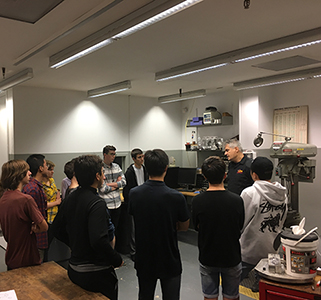
Mechanical Engineering Lab training
Finally, Sinisa Janjusevic, a technician and machinist, provides an overview of the Mechanical Engineering Workshop, located in rooms LL 218 & 219 of 41 Cooper (two floors underground). Students are required to take a two-hour shop safety class during their second or third week to be able to use the facility. “Don’t worry about not knowing how to build anything!” he reassures the class.
The next session will cover the four projects students will choose from for the semester. Stay tuned.
Class Three | 2 – 4 p.m. | Calculus I
Jenna received a five, the highest possible score, on her AP Calculus BC exam. However all engineering students that received a five and wish to credit out of the required Calculus I class and start with Calculus II must also pass the school's own much more rigorous placement exam. After completing the exam Jenna's faculty advisor thinks she would benefit from starting with Calculus I. So here she is. The class meets three times a week for a total of five hours. (We skipped classes two and three during Week One.) She likes the instructor, Professor Jose Diaz-Alban, and even though the information is familiar to her, at least during the first week, the pace has been quicker. “We covered today in one class what we would cover in two weeks in high school calculus.” There has been some new content, for example, the epsilon delta definition of a limit. It's no problem because Jenna loves math. “It just makes sense to me.”
Week One I Day Two I Wednesday, September 5
Class Four | 2 – 4 p.m. | Calculus I
See above.
Class Five | Computer Programming for Engineers
This 6 p.m. class falls right in prime dinner hour, which is often the only time adjunct professors can teach. In this case, the instructor is Sean Cusack BSE'98, who spends his days as a Senior Software Engineer at Deutsche Bank and has taught this class since 2002. The class takes place in a computer lab filled with Mac desktops set in rows. Each class will be a one hour lecture followed by a one-hour lab. Professor Cusack promises he will stay “as long as you need me” past the official end of the class time.
He outlines the course, which makes no assumptions about prior knowledge of computer programming. The course introduces how to use Linux via a command line interface. In later sessions students will examine how computers physically work, from the electrons outward, then eventually explore programming in C and Python. But the core premise is to work on problem-solving skills. There is a project assigned every week and it is due before class. In other words, he makes clear, no later than, "17:59:59.999 p.m. New York time.” The final projects involve creating two video games from scratch.
He acknowledges that most coding solutions can be found on the internet and that sharing code is part of programming culture. Professor Cusack is fine with that, so long as one cites the source in the code. In fact, he encourages collaborative work. “Help each other,” he urges, “Cooper is a very teamwork-oriented place."
Week One I Day Three I Thursday, September 6
Class Six | 10 – 10:50 a.m. | Calculus I
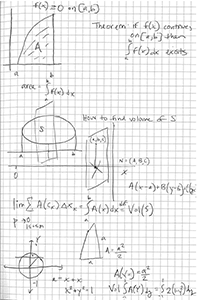
keeping up in Calculus class
See above.
Class Seven | 11 – 11:50 a.m. | Freshman Seminar
See above
Class Eight | 12 – 12:50 p.m. | Engineering Graphics
Taught in tandem with Jenna’s Computer Programming class the previous night, this is another requirement for all freshman engineers. To make things easier, or perhaps more confusing, the class is also taught by a Professor Cusack. This time, it’s Sean’s brother Brian Cusack ME'01/MME'03, who also works full-time as Cooper's Director of Campus Enterprise Applications. His course will cover 2CAD, 3CAD and solid modeling, mathematics software, and simulation software. He adds a logistical note.
“Engineering runs on Windows,” to a few grumbling students with open MacBooks.
He’s been teaching the class for a long time (“It’s the same content, even the jokes don’t change”). But he’s quick to tell us this will not be a step by step tutorial in graphics software. “You’ve grown up with computers and you’re capable of teaching yourself software,” he says. “I’m here to teach you how engineers will use it.”
Surprisingly to some, a major focus of the class will be hand drafting. He tells the class that someday they will be in a restaurant with clients and will need to describe a concept or design. In that situation, you may only have the back of a napkin on which to draw. “You’re going need to explain yourself without the crutch of technology.” Professor Cusack then describes in detail each drafting supply the students will be required to buy, leaving no questions unanswered. Even the preferred shade of graphite is specified.
Class Nine | 1 – 2:50 p.m. | Engineering Design and Problem Solving
It's an unbelievably jam-packed day with just three ten minute breaks over five hours but at least it ends with this. EID 101 may be the most anticipated class among freshman engineers since it’s less focused on fundamentals, and more on solving a real-world problem. During this second, longer class, the four professors spent around 20 minutes each describing their section’s project. First up is George Delagrammatikas, professor of mechanical engineering. He proposes taking a collection of artifacts, housed in a display case on the 7th floor of 41 Cooper, and repurposing them into a kinetic sculpture. The installation will be an exercise in prototyping and the formal engineering design process. It will also be a work of art that illuminates the history of The Cooper Union and New York City.
Next, Neal Simon Kwong, assistant professor of civil engineering, begins by asking the class, “What are basic human needs?” Students chime in: “food, water, shelter, WiFi!” His project focuses on the need for secure shelter, specifically in earthquake prone regions. Students will design an earthquake resistant building, constructing models that will be tested on a shake table.
Electrical engineering professor Toby Cumberbatch’s section similarly deals with the human need for shelter, but for displaced populations around the world. This group is tasked to build an economically viable, durable, and biodegradable shelter kit to be used by internally displaced persons.
Professor of Computer Science Anita Raja’s project also addresses a global problem: sufferers of diabetes in developing countries. Students will design and build low-cost lower limb prosthesis and glucometers that can be reproduced locally in Uganda, where they will focus the project.
After the presentations, the class is instructed to rank their choices, one through four, and place an asterisk if there’s a section they really want.
Update: Jenna learned the next week that she was placed in her first choice - the earthquake project. Her small group is already at work designing an earthquake-resistant museum. The group had the freedom to decide the use for the building. A museum won by a tight margin over a "vape stadium.”
Week One I Day Four I Friday, September 7
Class Ten | 1 – 2:50 p.m. | General Chemistry
Professor Samuel Weiner, a seasoned chemistry instructor, both at Cooper and on the high school level, surveys the class. “How many of you took AP chemistry in high school?” The class is split: eight, including Jenna, took the AP-level course while 14 stopped at regular chemistry. Prof. Weiner lays out expectations for the course. The class will have three exams which are not cumulative. “If you really try, you can get a C or a D,” he tells the class to frightened looks. But then he assures everyone that you have to try to really hard not to get a B or A. Sighs of relief follow.
Class time will be spent covering chapters in the book, which is also where homework will come from. He encourages class participation and questions. “The first 500 questions are free!” Professor Weiner dives right into the first lesson: classification of matter. His lectures are interactive; he speaks in open-ended sentences, encouraging students to complete his thoughts with the appropriate answer. From isotopes to standards of measurement, the material seems to be review for most students, even though many took their last chemistry class as high school sophomores.
At one point he instructs everyone to round a measurement of 2.245 centimeters to three significant figures. 2.25, right? Wrong. According to the textbook, when the number five is involved in rounding, you only round up when the digit to the left of the five is odd. If the digit to left of the five is even, you delete the five and leave the trailing value. Because of the rules of probability, any error will wash when this is used repeatedly, at least in chemistry. In this example, 2.245 would become 2.24. The class goes wild with disbelief. “I feel like I’ve been lied to!” “Is this a college rule?” Professor Weiner does his best to reassure them, but for many, this is symbolic of the huge adjustment to college life.
Week One I Days Five & Six I Saturday and Sunday, September 8 – 9
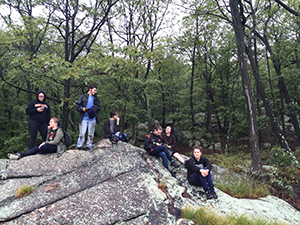
a weekend hike
Jenna spends her first weekend, in part, getting her bearings while shopping for groceries and remaining school supplies. She also catches up, via Youtube, on the action from her favorite hockey team, the San Jose Sharks. Why San Jose? Because they are sharks. She likes sharks. Plans are already in the works to see them play against the New York Islanders at the Barclays Center, a game that serendipitously falls on her birthday. During the weekend she also ventures out on a hiking excursion organized by Cooper’s Outdoors Club. “It started out slow but then got intense! And it rained,” she recapped later. Jenna plans to join several student organizations: the steel bridge team, the ultimate Frisbee team, Society of Women Engineers, and the Dungeons and Dragons club. She also plans to run for the position of Civil Engineering rep on the Engineering Student Council.
Week One I Day Seven I Monday, September 10
Class 11 | 10 a.m. – 11:50 p.m. | Intro to Linear Algebra
Though Jenna is an excellent math student, the concept of linear algebra is tough for her to grasp. “I’ve had to shift my thinking. It’s like algebra, but you have to explain it geometrically. Rather than using an equation to explain, I have to draw a picture in terms of vectors,” she gripes. But she really likes Professor Stanislav Mintchev. “He writes everything out which is very helpful.”
Class 12 | 12 – 12:50 p.m. | Engineering Professional Development Seminar
All engineering students are automatically registered for this non-credit course during their first four semesters at Cooper. Each semester the topic changes. The first semester explores the concept of communication for engineering and is taught by John Osburn, the associate director of communication workshops at the school of engineering. While the first meeting is from noon to 1 p.m., Jenna learns the remainder of the sessions will take place in the evenings. Students will attend four workshops from 6:15-9 p.m. throughout the semester. The workshops cover physical, written, vocal and group expression. The facilitators are experts in corporate training or performing arts (several have appeared on Law and Order!).
Just as Professor Osburn is explaining all this, a loudspeaker interrupts him. “Please let (inaudible) know her ambulance has arrived,” announces a security guard. Professor Osburn takes this as an opportunity to teach the downside of misplaced communication: “That announcement was not for us. Always know your audience.”
Class 13 | 1 – 2:50 p.m. | General Chemistry
The second session of a twice-weekly class. See above.
This jam-packed Monday starts the week for Jenna, but technically ends her first full week of classes.
Cooper Union students arrive having been the top of their high school class. So we wonder, how does it feel to now be one of many highly performing peers? “I’m comfortable being in the middle right now,” Jenna says. “Since I’m not ahead of the curve like in high school, it’s been more of a challenge, which is good.”
Some overall surprises? Only three of her eight professors have formal office hours. “I expect I will just have hunt them down in the hallway,” she says. Also, while most every class has homework assignments, only a few professors will be collecting it. The understanding is that you are free to skip it, but without the practice you will almost certainly fail the class. It's your choice. “So it’s really up to me to stay motivated!” Jenna exclaims.

